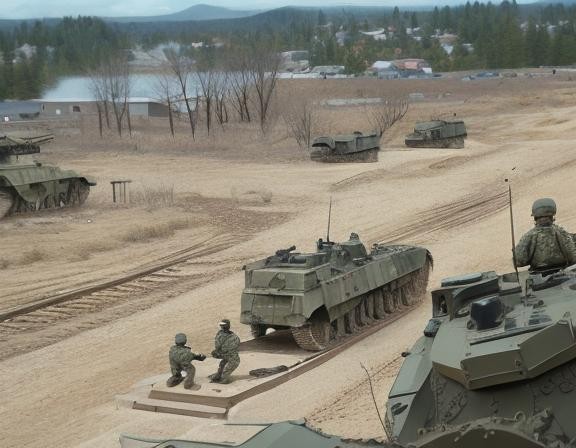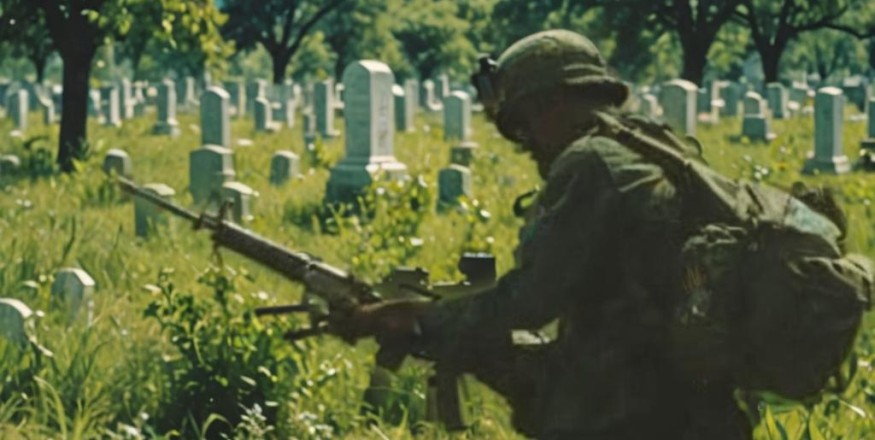 x
x
Six years after the war had ended, I returned to New Orleans. Although I never lived there for any length of time, it felt like coming back to a place both intensely familiar and fiercely exhilarating. This city, once a bustling staging area for soldiers fighting the relentless zombie hordes on American soil, now stood as a testament to survival and resilience, its streets echoing with memories of a battle that reshaped the nation.
There was a brand-new airport terminal building to replace the cramped little podunk setup that troops used to hustle through, dodging the watchful eyes of the local authorities. At the entrance to the airport, the cement block that once boldly declared, “The noble sacrifice of our boys will never be forgotten,” was still standing. The promise, long since abandoned, had been whitewashed away, but you could still make out the letters beneath the peeling paint, a ghostly reminder of what once was.
The road into the burg was much quieter now—no armored vehicles or American rides, and far more bicycles than the Harleys that used to jam up the streets. The air was a lot cleaner. But the streets were hauntingly familiar. The main drag, which ran from the Continental Hotel—where folks used to sit on the terrace to drink, chat, or jot down their thoughts—all the way to the port on the Mississippi, still had a bit of bustle. There were still stalls selling trinkets, cigarettes, and snacks. Business wasn’t as booming as it once was, but there were still large, awkwardly dressed foreigners meandering around. They weren’t Americans—they were Soviets or Eastern Europeans. It didn’t take long to notice that the Russians weren’t exactly popular. The locals had a nickname for them: “Us without dollars.”
The false fronts of the old dives where worn-out GIs had clumsily hooked up with bar girls were gone, but many of the bars were still up and running, with young men and women drinking inside. The difference now was that the men were locals, and hardly any of the girls were working girls anymore.
 54Please respect copyright.PENANABmkGOUJXuL
54Please respect copyright.PENANABmkGOUJXuL
But most extraordinary of all was the music. In the bars, those big, clunky wooden stereo consoles that had been all the rage fifteen years ago were still kicking, blasting tunes from the '60s and early '70s with a heavy dose of irony. The Grateful Dead, The Doors, Jimi Hendrix, The Beach Boys, The Stones—they were all there, spinning with a strange sense of nostalgia, played by locals who despised the Russians and were likely just kids when those tracks first hit the airwaves. Brought to their town by a vast and absurd, frightened and cruel army fighting a war on their own soil, that music had become an essential part of the fabric of this place. It was a key piece of what we called home, just like the GIs used to call the Zombie enemy the Zoms.
Tim Page, a photojournalist with a wild streak, found himself thrust into the heart of America's Zombie War in the 1960s. Originally a globe-trotting adventurer, Tim started documenting the chaos when the undead uprising first hit the U.S. heartland. He was never supposed to be in the thick of it, but fate, and his unshakable need to chase the untold stories, led him to become one of the war's most famous chroniclers. Armed with his camera and a reckless thirst for danger, he captured both the unimaginable horrors and the moments of bizarre normalcy that peppered the lives of soldiers battling the undead on their own turf.
"By the end of the '60s, the U.S. Army was a battle-worn, ragtag force—exhausted, battered, and forever changed. These soldiers weren't just fighting a foreign enemy; they were up against swarms of the undead, decaying, relentless, and incapable of fear. They fought in cities turned graveyards, often mere blocks away from bustling suburban neighborhoods where life somehow marched on. To make it worse, they’d patrol streets filled with iconic fast-food joints like McDonald’s, Burger King, and Kentucky Fried Chicken—but were forbidden from indulging in the greasy comfort that civilians devoured daily. The soldiers also couldn't touch other things like girls in mini-skirts or their cherished record players that played some of the decade's most iconic music as it could put them at risk of interaction with civilians. These were cruel reminders of the lives they could never truly return to.
The war had fractured the country into two worlds. On one side, a horrifying nation of war, zombies, and endless graveyards; on the other, a pristine, oblivious suburbia with all the trimmings—white picket fences, station wagons, and kids in poodle skirts. America’s nightmare and dream lived side by side, but only one would survive. The soldiers, trapped in the middle, began to question if the world they were fighting for even existed anymore.
 54Please respect copyright.PENANAYqdeDD090e
54Please respect copyright.PENANAYqdeDD090e
During the Zom wars, friendly fire incidents were common and often deadly. The chaos of battle, combined with the unpredictable behavior of the undead, made it difficult for soldiers to distinguish between friend and foe. Even with advanced targeting systems and clear communication protocols in place, mistakes still happened. One soldier recounted how he was shot by his own side while taking out a group of zombies that had overrun their position. "I didn't even see them coming," he said. "One minute I'm firing at the zombies, and the next thing I know I'm hit from behind." It turned out that one of his own teammates had mistaken him for a zombie and opened fire. These kinds of accidents happened all too often during the war, leaving many soldiers traumatized by the experience. Even those who survived had to live with the knowledge that they could be killed by their own comrades at any moment.
Page had gotten into the habit of looking like a zombie during his time in the war, and it was starting to affect him mentally. He'd developed an uncanny ability to blend in with the undead; he could walk around without attracting attention from other soldiers while still managing to stay alive himself. But after getting shot by friendly fire on one occasion, Page decided that enough was enough—he needed to change his appearance. "I realized how I looked from their point of view," he said. "I was pale as a ghost, with dark circles under my eyes and matted hair. And when I came back from London, they were shocked at how much weight I had lost." So, he took matters into his own hands and began wearing glasses and growing out his beard, hoping that these changes would make him less recognizable as a soldier.
He'd gotten careless while taking pictures of a zom that had climbed up a tree and was trying to attack a group of civilians. He got too close to the creature, not realizing how quickly it could move, and before he knew it, the zombie had lunged at him. The buck private who shot him mistook him for one of the undead and opened fire. Page had been trying to capture the moment when the zombie tried to grab hold of its prey, but he wasn't paying attention to his own safety. It was a risky move for any photographer in a war zone—especially during a time when zombies were becoming more aggressive and unpredictable.
He remembers staggering around trying to take more pictures before falling down on the ground. MEDVACed to a hospital in Pine Bluff, Arkansas, he heard a doctor saying "He's got twenty minutes to live! He survived a hemorrhage and tissue the size of an orange from the space where his brain had been.
He survived the 20 minutes ("How many minutes have I got left now?" he asked at one moment) and they flew him to Chicago and then to the Walter Reed Army Hospital in Washington. While in Chicago, they refilled his head with epoxy resin and covered it with what he called astroturf. He would always be paralyzed down the left side, they said. To hell with that, he replied, and gradually forced jerky movement back into almost all his body. But the happy childhood days playing with the undead, the evil magic that brought them to life, and the toys of war, were gone forever.54Please respect copyright.PENANA323Ta5srAU
Time-Life paid all his medical bills and, after persuading him to sign a form releasing the corporation from any further responsibility for him, gave him a pourboire of $15,000. But his wounds made it hard for him to work. The 'seventies were an unhappy time for Page, as they were for thousands of American veterans who had fought a vicious zombie uprising on home soil—returning to families who recoiled at the sight of their mangled bodies, shattered minds, haunting memories, and ever-present terrors. Like many of them, Page hung around ("goofed" was no longer an appropriate term), with only the odd job here and there as he tried to get what was left of his head together. Not easy. For him, as for so many neglected vets, there was still too much of that grisly homefront zombie war whirring and sawing its way beneath the astroturf. Fortunately, a keen lawyer found him and suggested that---as well as maybe making some money---suing Time-Life might help to exorcise 1969 and all that. He slapped in a writ for $5 million damages on the grounds that the corporation had not met its obligations to him. He had to convince the jury that he was legally insane---could not manage his own affairs----when he signed the release. Since people have always thought him mad, this was not impossible. Eventually he won the case and, although he was awarded only $125,000, it was quite a victory for the freelance. Most veterans, sadly, had no such recourse.
It was not until the inordinate celebrations given the hostages returning from Teheran that millions of Americans realized that the former zombie fighters had not been paid their dues.
Page was a little luckier; for him, things started to turn around in 1977 with the publication of Michael Herr's Dispatches—a raw chronicle of the '60s Stateside zombie war. Page, one of the central figures in that grim chapter, later confessed that the book’s success began to mythologize him. Herr vividly recounts the wild, stoned escapades they indulged in amidst the carnage, declaring, “The zombie war was what we had instead of happy childhoods.
He quotes Page's reaction, after his brain was remade, to a request from a British publisher for a book which would "finally take the glamour out of war."
"Strip the glamour from war! I mean, how the hell do you do that? Try stripping the allure from a roaring Huey or a slick Sheridan—can you drain the charm from a Cobra or from getting stoned on Coney Island’s boardwalk amid the undead chaos? War’s got its own magnetism—you just can’t take the glamour out of it. It’s like trying to remove the magic from sex or dull the shine of the Rolling Stones… it just can’t be done."
Dispatches led to a revival of interest about Page's work. In 1980 the BBC made a film about him, and he was given an exhibition at the Institute of Contemporary Arts in London. On both occasions "the glamour of war" was an issue. At the Institute the rather left-wing audience listened aghast as he regaled them with tales of how groovy it had been playing with choppers and tanks and piloting Skyraiders. One middle-aged woman seemed almost apologetic when she asked whether it was quite such fun for those who were killed.
War has always been imbued with glamour, glory, machismo, and daring feats. Page says, rather more boldly, what many—men and women, soldiers and civilians, journalists and bystanders alike—felt during the Stateside zombie war. It’s also true that war photography has long captured images of haunting beauty alongside the horrors of combat, images that immortalize the battle not against foreign foes, but against the very monsters ravaging our own homeland.
Page's photographs capture the exquisite beauty of our nation during the zombie uprising better than any war images I've ever seen. Rendered in vibrant color, they let you feel both the searing heat of a Southern summer and the soft, golden light of an autumn dawn. In one striking shot, a metal helicopter beast descends beside a weathered tractor in a rolling Midwestern field, a surreal testament to the clash of pastoral peace and relentless conflict.
But there's a danger that the beauty of these pictures might conceal the true horror of what Page captured. Take, for instance, the powerful image of a MEDEVAC helicopter slicing through the thick, pink smoke to lift the wounded from a zombie ambush, or the striking shot of GIs in their blue fatigues trudging away through the shadowed woodlands, their faces grim as the undead close in around them.
Page insisted that all he ever captured were "reality pictures," and that's exactly what he did. Yet in that sprawling Stateside zombie war, as in any conflict, there were thousands of distinct realities unfolding. Other photographers, like Philip Jones Griffiths, chose instead to focus on the civilian toll wrought by the undead assault. Perhaps Page's most striking pictures are of the GIs, poor whites and blacks plucked from the ignorant and often innocent island of the heartland and cast without understanding or preparation into an utterly alien and terrifying world. Perhaps Page's most striking images are those of the soldiers—poor whites and blacks plucked from the sheltered innocence of America's heartland and thrust, without warning or preparation, into an utterly alien and terrifying realm overrun by the undead. In his photographs and commentary, Page captured the 'sixties psychedelic side of GI culture, the absurdity of their predicament, and the refuge they sought in dope and rock. This facet of the conflict—fought right here on American soil—was uniquely its own, a stark reality of our zombie war.
Some of the other images—of refugee shanties reduced to rubble by bombing runs, of detained suspects condemned after their harrowing encounters with the undead, and of a boy weeping over the lifeless body of his sister—lay bare the everyday horrors common to every war: the collapse of society, and the agonizing, undignified deaths of children and parents. There is no glamour in that reality. Across America, even soldiers who had a brush with the undead still bear the scars—both visible and hidden—of that relentless nightmare, a testament to a conflict that continues to haunt our nation.54Please respect copyright.PENANAeHONzKYcGP
In America, the pity of war has been followed by a peace just as cruel. The defeat of the undead did not bring unity or healing. In New Orleans—now ruled by the houngans, its streets thick with whispers of old magic—poor kids still sing, "I gotta get outta this place, if it's the last thing I ever do.54Please respect copyright.PENANAtrJEIBUbEC























